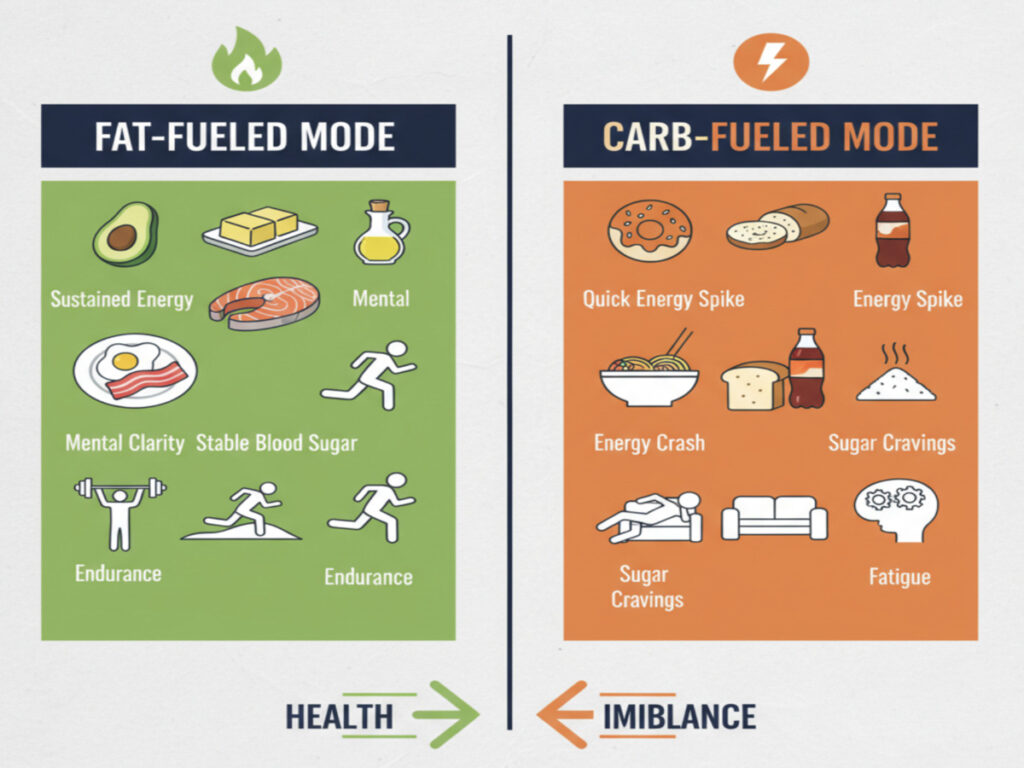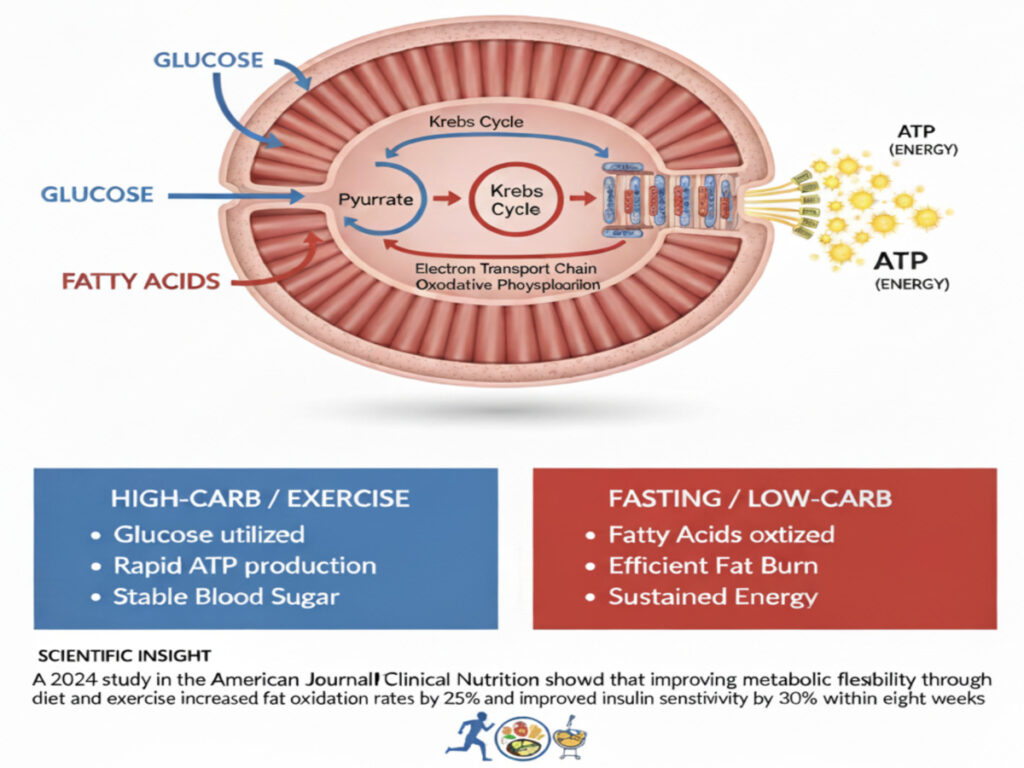Introduction: What Is Metabolic Flexibility Training?
Metabolic flexibility training focuses on improving the body’s ability to efficiently switch between using carbohydrates and fats for energy. In simple terms, it’s about optimizing your metabolism so your body can easily adapt to different energy demands—whether you’re fasting, working out, or resting.
In 2025, Americans continue to struggle with metabolic rigidity due to high sugar intake, poor sleep, and sedentary lifestyles. According to the CDC, nearly 1 in 3 adults in the U.S. show signs of insulin resistance, making metabolic flexibility training one of the most promising approaches to restore energy balance and prevent chronic diseases.

The Science Behind Metabolic Flexibility
Metabolic flexibility relies on your body’s mitochondria—the energy powerhouses inside cells—to efficiently switch fuel sources. A metabolically flexible body can:
- Burn fat efficiently during fasting or low-carb periods.
- Use carbohydrates quickly when energy demand spikes (e.g., exercise).
- Maintain stable blood sugar levels between meals.
When the body becomes metabolically inflexible (due to constant high-carb diets or lack of movement), it loses this adaptive ability—leading to fatigue, poor endurance, and metabolic diseases.
Scientific Insight:
A 2024 study in the American Journal of Clinical Nutrition showed that improving metabolic flexibility through diet and exercise increased fat oxidation rates by 25% and improved insulin sensitivity by 30% within eight weeks.

Benefits of Metabolic Flexibility Training
Enhanced Fat Burning Efficiency
Metabolic flexibility allows your body to burn stored fat effectively, particularly during low-intensity activity or fasting. This not only supports weight loss but also reduces dependency on frequent meals and snacks.
Expert Quote:
“When your metabolism adapts seamlessly between carbs and fats, you stop being a ‘sugar burner’ and become an efficient energy machine,” says Dr. Rebecca Owens, Exercise Physiologist, UCLA.
Improved Energy Balance
A flexible metabolism helps stabilize energy levels throughout the day, reducing mid-afternoon crashes and improving focus. This is especially valuable for busy Americans balancing work and fitness.
Better Insulin Sensitivity
Training metabolic flexibility enhances glucose uptake by muscles, preventing insulin resistance and supporting better blood sugar control.
Long-Term Metabolic Health
Over time, metabolic flexibility supports heart health, reduces inflammation, and lowers the risk of type 2 diabetes and obesity-related conditions.
How to Improve Metabolic Flexibility
1. Practice Intermittent Fasting
Start with 12–14 hour fasts to encourage fat oxidation. Gradually extend fasting windows if tolerated.
2. Alternate Carb Intake
Use “carb cycling” — higher carbs on workout days, lower carbs on rest days — to keep the body adaptive.
3. Combine Strength & Cardio Training
Strength training boosts insulin sensitivity, while aerobic exercise enhances mitochondrial efficiency.
4. Sleep & Recovery Optimization
Sleep deprivation reduces metabolic flexibility by impairing glucose tolerance. Aim for 7–9 hours per night.
5. Manage Stress Levels
Chronic stress elevates cortisol, which reduces the body’s ability to burn fat effectively.
Suggested image placement:
A visual routine combining fasting, nutrition, and training flow.
Practical Checklist for Daily Optimization
✅ Begin mornings with light movement or fasted walks
✅ Eat whole, unprocessed foods high in fiber and protein
✅ Limit refined sugars and processed carbs
✅ Hydrate with at least 2–3 liters of water daily
✅ Incorporate resistance training 3–4x per week
✅ Ensure consistent sleep and stress management
Metabolic Flexibility Comparison Table
| Aspect | Metabolically Flexible Body | Metabolically Inflexible Body |
|---|---|---|
| Energy Levels | Stable throughout the day | Frequent fatigue or crashes |
| Fuel Source | Switches easily between fat & carbs | Dependent mostly on carbs |
| Insulin Sensitivity | High | Low |
| Fat Storage | Minimal, efficient utilization | Accumulation over time |
| Workout Recovery | Faster, more efficient | Slower, muscle soreness common |
Expert Insights
“Most people are unknowingly metabolically inflexible because they eat constantly. Building flexibility means teaching your metabolism to function efficiently between meals,” says Dr. David Chen, Metabolic Health Researcher, Johns Hopkins University.
“A metabolically flexible person can thrive under fasting, exercise, or high-carb situations—it’s the hallmark of true metabolic health,” adds Dr. Monica Green, RD, Clinical Nutritionist.
Common Myths & FAQ
Q1: Can I achieve metabolic flexibility without exercise?
A: Exercise accelerates adaptation, but nutrition alone can initiate improvement through fasting and carb modulation.
Q2: Do I need to cut out carbs completely?
A: No. The goal is to cycle carbs intelligently, not eliminate them.
Q3: How long does it take to become metabolically flexible?
A: Most people notice changes in energy and fat metabolism within 4–6 weeks.
Q4: Can metabolic flexibility help with weight loss plateaus?
A: Yes, by training your metabolism to tap into stored fat more effectively.
Authoritative Resources
- National Institutes of Health – Metabolic Health Research
- American Diabetes Association – Insulin Sensitivity & Nutrition
- Harvard Health Publishing – Understanding Metabolism
Related Fitoast Articles
- Fibermaxxing: Maximizing Dietary Fiber for Gut Health, Satiety, and Long-Term Wellness
- Rucking & Weighted Walks: The Simple Fitness Trend Transforming American Health
Conclusion & Call-to-Action
Metabolic flexibility training is more than a buzzword—it’s the foundation of lasting energy, fat control, and metabolic wellness. By optimizing nutrition, exercise, and recovery, you can transform your body’s energy system into an adaptable, resilient powerhouse.
Next Step: Start with simple changes—reduce processed carbs, add movement after meals, and prioritize sleep. In a few weeks, you’ll notice steadier energy, sharper focus, and improved fat metabolism.

